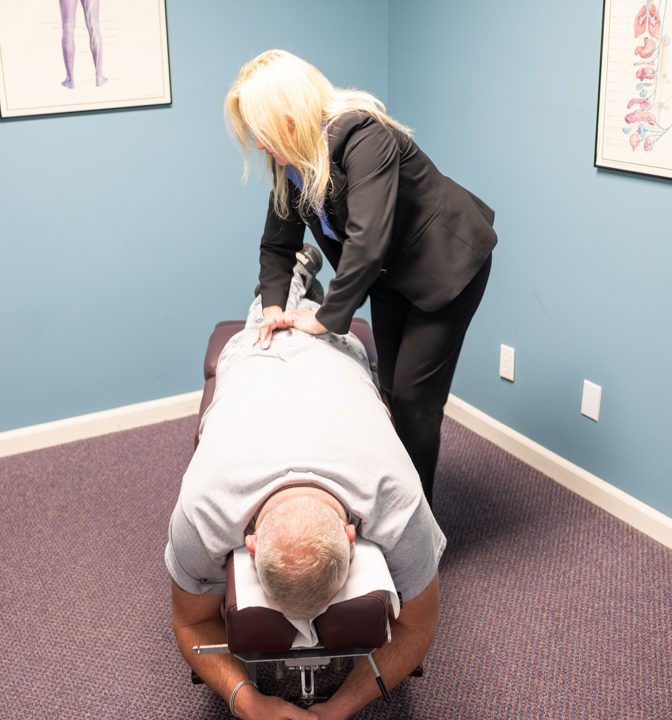
Chiropractor for Sciatica Pain Relief | North Atlanta Chiropractic Center
Are you suffering from the sciatica-like shooting pain, numbness, or tingling that radiates from your lower back down through your leg? Sciatica can be debilitating, affecting your ability to work, sleep, and enjoy daily activities. At North Atlanta Chiropractic Center in Duluth, GA, our chiropractors specialize in providing effective, non-invasive sciatica pain relief without relying on medications or surgery.
Se Habla Español
AS SEEN ON:





Why Choose Our Chiropractor for Sciatica Care
With over 20 years of experience serving the Gwinnett County community, Dr. Angela Amaral brings unparalleled expertise to every sciatica case. Our practice stands out because we don’t just treat symptoms—we identify and address the root cause of your sciatica. Our chiropractic care is a trusted option for many patients.
What sets North Atlanta Chiropractic Center apart:
- Board certifications in multiple therapeutic disciplines
- Comprehensive assessment of your specific sciatica condition
- Personalized treatment plans tailored to your unique needs and overall wellness
- Award-winning care (recognized with The Best Of Gwinnett award)
- Drug-free, non-surgical method for lasting improvement
- Same-day appointments for those in acute pain
- Convenient location in Duluth serving all surrounding communities
Personalized Sciatica Pain Management Programs
North Atlanta Chiropractic Center provides customized sciatica pain management programs that address your specific condition and lifestyle needs. We understand that this nerve condition can stem from various causes—herniated discs, spinal stenosis, piriformis syndrome, or sacroiliac joint dysfunction—each requiring a different therapeutic method. Our chiropractors are skilled in identifying the precise cause.
During your initial consultation, Dr. Amaral will conduct a thorough examination to determine the exact source of your sciatic pain. Using this information, we develop a personalized care protocol that may include a combination of chiropractic adjustments, spinal decompression therapy, corrective exercises, physical therapy, and manual therapy techniques.
Our patients appreciate our holistic care that considers all aspects of your health, not just your symptoms. By addressing underlying postural issues, muscle imbalances, and spinal misalignments, we help you achieve not only immediate improvement but long-term prevention of future sciatica flare-ups.

Expert Spinal Adjustments for Sciatica Relief
North Atlanta Chiropractic Center provides precise chiropractic adjustments specifically designed to alleviate nerve compression and restore proper spinal function. Dr. Amaral is highly skilled in multiple adjustment methods, including Thompson, Gonstead, Toggle, Pierce, and Sacro Occipital, allowing her to select the most effective plan for your particular condition.
When the vertebrae in your lower spine become misaligned, they can put pressure on the sciatic nerve, causing the characteristic pain that radiates down your leg. Our expert chiropractic adjustments and each spinal adjustment gently realign these vertebrae, creating space for the nerve and reducing inflammation in the surrounding muscles and tissues.
Many patients experience significant improvement after just a few sessions, though the exact timeline varies depending on the severity and duration of your condition. Throughout your chiropractic care, we’ll continually assess your progress and adjust your care plan as needed to ensure optimal results.
Our patients consistently report not only reduced pain but also improved mobility, better sleep quality, and enhanced overall well-being following our sciatica-focused chiropractic adjustments. As one patient recently shared, “After suffering from sciatica for years and trying everything, the chiropractor’s adjustments finally gave me my life back.”
Comprehensive Lower Back Pain Treatment
North Atlanta Chiropractic Center provides thorough lower back pain treatment that addresses both immediate comfort and long-term resolution of sciatica symptoms. Our comprehensive treatment targets not just the pain itself but the underlying spinal misalignments, muscle imbalances, and postural issues that contribute to sciatic nerve compression.
Your care begins with a detailed assessment of your lower back, including range of motion testing, postural analysis, and, when necessary, diagnostic imaging to identify structural issues like herniated discs or spinal stenosis. This thorough evaluation allows our chiropractors to develop a targeted treatment strategy specific to your condition.
Your personalized lower back pain protocol may include:
- Precise spinal adjustments to correct vertebral misalignments
- Soft tissue therapy, like trigger point therapy, to release tight muscles compressing the sciatic nerve
- Core strengthening exercises to improve spinal stability
- Posture correction techniques to prevent recurrence
- Lifestyle recommendations to support healing and the health of your spine
Many patients with chronic lower back pain and sciatica have found lasting comfort through our integrated care when other treatments failed. By addressing both the symptoms and their underlying causes, we help you achieve sustainable pain relief and improved function.
Advanced Decompression Therapy for Nerve Pain Relief
North Atlanta Chiropractic Center provides revolutionary spinal decompression therapy that creates negative pressure within the spinal discs, effectively relieving pressure on the affected nerve. This non-surgical treatment is especially beneficial for patients suffering from herniated discs, bulging discs, or spinal stenosis—common causes of this type of nerve compression.
During a therapy session, you’ll lie comfortably on our specialized table while the computer-controlled system gently stretches and relaxes your spine in a precisely calculated sequence. This cycling action creates a vacuum effect within the affected disc, which accomplishes two critical healing functions:
- It pulls retracted disc material back toward its proper position, relieving nerve pressure
- It promotes the influx of oxygen, nutrients, and healing fluids into the disc area
Each session typically lasts 20-30 minutes and is entirely painless—many patients even find the experience relaxing. A full care protocol usually consists of 12-20 sessions over 4-6 weeks, though many patients report significant improvement after just a few treatments.
Our advanced decompression has helped countless sciatica patients avoid surgery while achieving remarkable results. Combined with our chiropractic adjustments and therapeutic exercises, this treatment offers a comprehensive solution for even the most persistent sciatica pain.
Neck Tension Relief and Posture Correction
North Atlanta Chiropractic Center provides specialized neck tension relief that addresses a common but often overlooked contributor to sciatica pain. While it might seem counterintuitive, poor neck posture and cervical spine misalignments can create a domino effect of compensations throughout your spine, ultimately affecting your lower back and nerve function.
Dr. Amaral’s expertise as a chiropractor in chiropractic biophysics allows her to identify these whole-body patterns and correct them at their source. During your treatment, we’ll address:
- Forward head posture (text neck) that places up to 60 pounds of strain on your neck
- Upper cervical misalignments that alter your entire spinal curve
- Muscle imbalances between your shoulder blades that affect spinal stability
- Compensation patterns that transfer stress to your lower back
Our neck tension relief protocol includes gentle cervical adjustments, targeted muscle release methods, and practical posture education. We’ll teach you how to maintain proper head position during daily activities, especially when using electronic devices—a major contributor to modern posture problems.
By addressing these upper body issues alongside direct sciatica treatment, we provide more complete and lasting comfort. Many patients are surprised to discover how much their neck position affects their lower back comfort and sciatic nerve function.
Ergonomic Education to Prevent Sciatica Flare-ups
North Atlanta Chiropractic Center provides essential ergonomic education to empower you to prevent sciatica flare-ups long after your treatment is complete. Understanding how to properly sit, stand, and lift is crucial for maintaining spinal health and keeping your sciatic nerve free from irritation.

Ergonomic Education to Prevent Sciatica Flare-ups
North Atlanta Chiropractic Center provides essential ergonomic education to empower you to prevent sciatica flare-ups long after your treatment is complete. Understanding how to properly sit, stand, and lift is crucial for maintaining spinal health and keeping your sciatic nerve free from irritation.
Answering Your Top Questions About Sciatic Leg Pain
If you’re dealing with the sharp, radiating pain of sciatica, you likely have a lot of questions. You want to understand why this is happening and, more importantly, how you can find a solution. At North Atlanta Chiropractic, we believe in empowering our patients with knowledge. Below, we’ve answered some of the most common questions we hear from patients and see in online health communities for 2025.
What is the difference between general back pain and sciatica?
This is a crucial distinction. General back pain is typically localized to your lower, middle, or upper back. It can be a dull ache or a sharp pain, but it usually stays in the back. Sciatica is different because it involves nerve compression. The pain is caused by irritation of the sciatic nerve, so it rarely stays in one place. The hallmark of sciatica is pain that radiates from the lower back, through the buttocks, and down the back of one leg. It’s often described as a sharp, shooting, or electric shock-like pain, and it can be accompanied by numbness, tingling, or weakness in the affected leg or foot.
Can my daily habits make my sciatica worse?
Absolutely. Modern lifestyles can be a primary contributor to sciatica symptoms. Some of the most common culprits include:
- Prolonged Sitting: Sitting for hours, especially with poor posture or on an unsupportive chair, puts immense pressure on your lumbar discs and can irritate the nerve.
- Poor Posture: Whether you’re standing or sitting, slouching causes your spine to move out of its proper alignment, which can lead to disc issues and nerve compression.
- Improper Lifting: Using your back instead of your legs to lift heavy objects is a classic cause of herniated discs, a primary trigger for sciatica.
- Lack of Core Strength: Weak abdominal and back muscles fail to properly support the spine, leaving it vulnerable to injury and misalignment.
Should I use ice or heat for my sciatica pain?
This is a common question, and the answer depends on the timing of your injury. In the first 48-72 hours after the pain starts (the acute phase), ice is generally recommended. Applying an ice pack wrapped in a towel for 15-20 minutes can help reduce inflammation and numb the sharp pain. After the initial inflammatory phase, heat can be more beneficial. A heating pad or warm bath can help relax tight muscles that may be contributing to the nerve compression and improve blood flow to the area, which promotes healing.
What are the best positions for sitting and sleeping with sciatica?
Finding a comfortable position can feel impossible, but a few adjustments can provide significant improvement. When sitting, ensure your feet are flat on the floor, your back is straight, and you have good lumbar support. Try placing a small rolled-up towel in the curve of your lower back. When sleeping, it’s often best to avoid sleeping on your stomach. If you’re a back sleeper, place a pillow under your knees to reduce pressure on your spine. If you’re a side sleeper, sleep on your non-painful side and place a pillow between your knees to keep your hips, pelvis, and spine in alignment.
When should I see a chiropractor versus a medical doctor?
Both chiropractors and medical doctors play important roles, but their methods differ. A medical doctor will often focus on managing your symptoms, typically through pain medication, muscle relaxers, or steroid injections. These can provide temporary comfort but may not address the underlying structural cause of the problem.
A chiropractor, on the other hand, focuses on identifying and correcting the root cause of the nerve compression. Through gentle spinal adjustments, spinal decompression, and targeted exercises, we work to restore proper spinal alignment, take pressure off the nerve, and allow your body to heal itself naturally and for the long term. For many people, comprehensive chiropractic care is a highly effective, non-invasive first line of defense against sciatica.
Are there “red flag” symptoms I should watch out for?
Yes. While most cases of sciatica can be managed effectively with conservative care, there are certain symptoms that require immediate medical attention. Please go to an emergency room if your sciatica is accompanied by any of the following:
- Loss of bowel or bladder control.
- Numbness or weakness that is severe or rapidly getting worse.
- Saddle anesthesia (numbness in the groin or inner thighs area).
- Pain that is the result of a severe accident or trauma.
These can be signs of a serious condition called Cauda Equina Syndrome, which requires urgent medical intervention.
Can sciatica go away on its own, or will it come back?
Sometimes, acute sciatica from a minor muscle strain may resolve on its own within a few weeks. However, if the pain is caused by an underlying structural issue like a herniated disc, spinal stenosis, or a misaligned vertebra, it is unlikely to fully resolve without expert treatment. Even if the pain subsides, the underlying problem remains, making flare-ups highly likely in the future. Addressing the root cause with our chiropractic care is the best way to not only find pain relief now but also prevent the pain from returning and becoming a chronic issue.

Contact Us Today
Don’t let sciatica pain control your life any longer. North Atlanta Chiropractic Center is ready to help you find lasting relief through our proven, personalized approach to sciatic nerve treatment. With over two decades of experience and countless success stories, Dr. Angela Amaral has the expertise to address even the most challenging sciatica cases.
Take the first step toward a pain-free life by calling our Duluth office today at (770) 450-9575 to schedule your consultation. We offer same-day appointments for acute cases and will work with your schedule to ensure you receive the care you need without delay.
